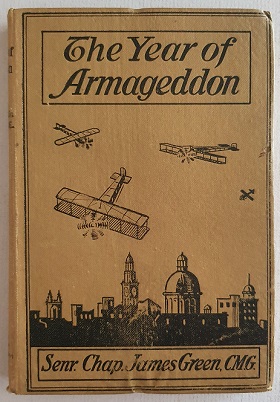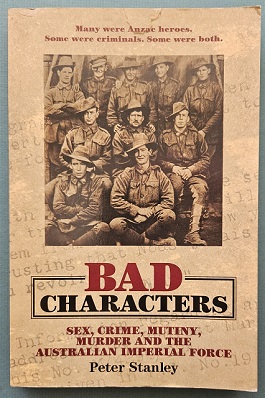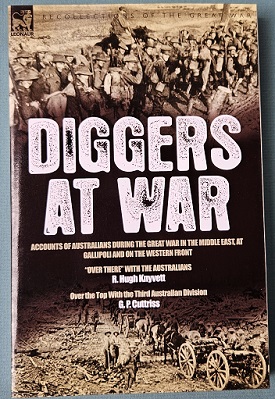Description
Title: The Year of Armageddon
Author: Senior Chaplain Green, James
Condition: Very Good
Edition: 1st Edition
Publication Date: 1919
ISBN: N/A
Cover: Hard Cover without Dust Jacket – 206 pages
Comments: The author’s reflections of the battles of World War One were part of his addresses given during his year of office as president of the Methodist Conference of New South Wales.
James Green (1864-1948), clergyman and military chaplain, was born on 14 October 1864 at Newcastle upon Tyne, England, son of William Green, journeyman mason, and his wife Isabella, née Palmer. He was educated at Rutherford College, Newcastle upon Tyne, and was a teacher before migrating to New South Wales in 1889 and entering the ministry of the Primitive Methodist Church. He served in parishes in the Newcastle area, married Caroline Jane Atkinson on 19 April 1893 at Annandale, Sydney, and was appointed to Marrickville in 1894. In February 1900 he sailed as Wesleyan chaplain to the New South Wales Citizens’ Bushmen, raised for service in the South African War. When the contingent returned home in June 1901 he served with troops in training before re-embarking with the 1st Australian Commonwealth Horse.
At Eland’s River, Green was captured by the Boers but his imprisonment was short lived. Following the death, illness or evacuation of many newspaper correspondents he became the sole Australian correspondent, sending regular reports to the Sydney Morning Herald. These became the basis of The Story of the Australian Bushmen (1903), his first book, which was a straightforward account of service, somewhat romanticized, but sensitive to the evils of warfare. Of Eland’s River he wrote: ‘It is easy to … throw a glamour over an engagement, but the truth should be told. One has to be in an engagement to see what “the glorious death of the soldier” really is in these times of modern artillery. One man was lying with an arm blown away, and a great hole in his side such as is made in the earth with a shovel’. He returned to Sydney in 1903 and after three country postings was appointed to Newtown in 1912. He also acted as a part-time chaplain to the Commonwealth Military Forces.
Green was a logical choice for the senior Methodist chaplaincy on the formation of the Australian Imperial Force in August 1914. He was appointed chaplain colonel with the 1st Battalion. He claimed to have landed at Anzac Cove on 25 April 1915. This is unlikely; however, he was one of the first chaplains ashore and probably conducted the first formal burial party. His service at Gallipoli impressed on him the ‘bedrock simplicity’ of the men. With A. E. Talbot, an Anglican, he conducted a joint communion service, a rare event because communion was reckoned as a sign of membership of a particular church. He left Gallipoli on 29 June, returning to Egypt to take charge of hospital visitations and continued to exercise the practical ecumenism learnt at Gallipoli.
Green worked with the Red Cross and comforts funds authorities in Egypt to secure supplies for the troops at Gallipoli, such as the first consignment of mosquito netting and crude petroleum. He considered this ‘one of the most useful things done during [his] chaplaincy’ as the supplies saved many lives by preventing the spread of disease. He returned to Gallipoli on 9 November but was soon evacuated when he injured his knee. He reached the 3rd Australian General Hospital, Lemnos, and, although a patient, resumed duty because there was no other chaplain available. He served with the 55th Battalion from its formation and accompanied his men in the trenches in France in 1916 and through the battle of Fromelles and the first battle of the Somme. Then from December 1916 to April 1917 Green was attached to A.I.F. Headquarters in London. Moved by the sight of Australians loitering on the streets, he gained the co-operation of the Australian Young Men’s Christian Association and the Wesleyan Army and Navy Board, and opened a recreation centre in Horseferry Road which became a focal point of A.I.F. life in London.
Green returned to the front regularly but became seriously ill in November 1917 and was invalided to Australia. He had been awarded the Distinguished Service Order for tending wounded men ‘under a barrage … in the front line trenches, Fleurbaix’, in September-October 1916 and for similar work previously at Fromelles. He was appointed C.M.G. in 1918 and twice mentioned in dispatches. As one of the longest-serving A.I.F. chaplains he was recognized by the New South Wales Methodist Conference which elected him president for 1918. He devoted this year to establishing the Church’s War Memorial Hospital at Waverley. He published two books arising from his experiences at the front: News from No Man’s Land (1917) and The Year of Armageddon (1919). His letters home, in which he strove for realism, were published in the Methodist.
Green’s war experience left a permanent mark on his ministry. He was a very approachable man who hated aloofness or snobbery of any kind. He asserted that institutional Christianity had ‘humbugged’ men and interfered with the relationship between man and God. His ministry continued in Sydney, first at Paddington, then at Croydon Park. In 1927 he became commissioner for Leigh College, the Methodist theological institution. He retired from active ministry in 1934 and in 1935 wrote From my Hospital Window, a series of essays on ‘sane democracy’. This book is his best: he emerges as a good-natured, tolerant, faithful man, compassionate towards the unemployed and other victims of economic crisis. His other books were The Selector (1907) and The Lost Echo (1910).
Survived by his wife and two sons, Green died on 6 November 1948 at Waverley and was buried in Rookwood cemetery.




